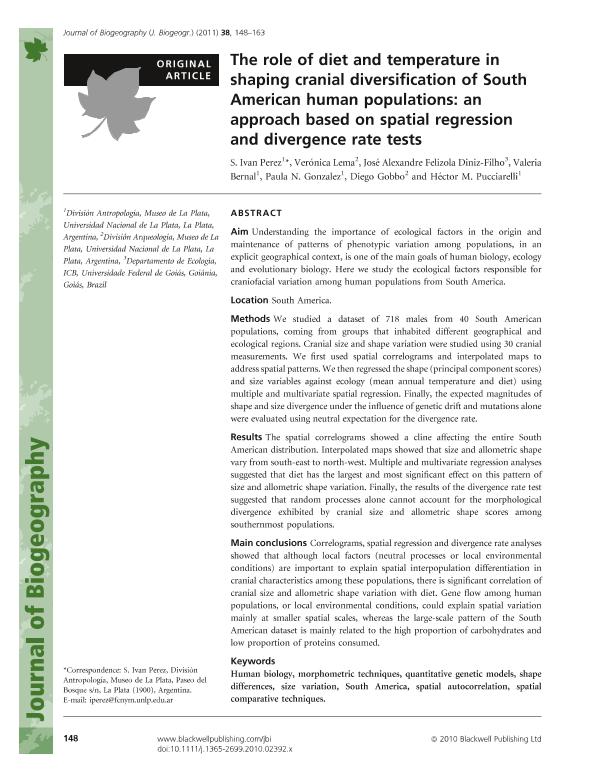Artículo
The role of diet and temperature in shaping cranial diversification of South American human populations: An approach based on spatial regression and divergence rate tests
Perez, Sergio Ivan ; Lema, Verónica; Diniz-Filho, José Alexandre Felizola; Bernal, Valeria
; Lema, Verónica; Diniz-Filho, José Alexandre Felizola; Bernal, Valeria ; Gonzalez, Paula Natalia
; Gonzalez, Paula Natalia ; Gobbo, Juan Diego
; Gobbo, Juan Diego ; Pucciarelli, Hector Mario
; Pucciarelli, Hector Mario
 ; Lema, Verónica; Diniz-Filho, José Alexandre Felizola; Bernal, Valeria
; Lema, Verónica; Diniz-Filho, José Alexandre Felizola; Bernal, Valeria ; Gonzalez, Paula Natalia
; Gonzalez, Paula Natalia ; Gobbo, Juan Diego
; Gobbo, Juan Diego ; Pucciarelli, Hector Mario
; Pucciarelli, Hector Mario
Fecha de publicación:
09/2010
Editorial:
Wiley Blackwell Publishing, Inc
Revista:
Journal of Biogeography
ISSN:
0305-0270
Idioma:
Inglés
Tipo de recurso:
Artículo publicado
Clasificación temática:
Resumen
Aim- Understanding the importance of ecological factors in the origin and maintenance of patterns of phenotypic variation among populations, in an explicit geographical context, is one of the main goals of human biology, ecology and evolutionary biology. Here we study the ecological factors responsible for craniofacial variation among human populations from South America.Location- South America.Methods- We studied a dataset of 718 males from 40 South American populations, coming from groups that inhabited different geographical and ecological regions. Cranial size and shape variation were studied using 30 cranial measurements. We first used spatial correlograms and interpolated maps to address spatial patterns. We then regressed the shape (principal component scores) and size variables against ecology (mean annual temperature and diet) using multiple and multivariate spatial regression. Finally, the expected magnitudes of shape and size divergence under the influence of genetic drift and mutations alone were evaluated using neutral expectation for the divergence rate.Results- The spatial correlograms showed a cline affecting the entire South American distribution. Interpolated maps showed that size and allometric shape vary from south-east to north-west. Multiple and multivariate regression analyses suggested that diet has the largest and most significant effect on this pattern of size and allometric shape variation. Finally, the results of the divergence rate test suggested that random processes alone cannot account for the morphological divergence exhibited by cranial size and allometric shape scores among southernmost populations.Main conclusions- Correlograms, spatial regression and divergence rate analyses showed that although local factors (neutral processes or local environmental conditions) are important to explain spatial interpopulation differentiation in cranial characteristics among these populations, there is significant correlation of cranial size and allometric shape variation with diet. Gene flow among human populations, or local environmental conditions, could explain spatial variation mainly at smaller spatial scales, whereas the large-scale pattern of the South American dataset is mainly related to the high proportion of carbohydrates and low proportion of proteins consumed.
Archivos asociados
Licencia
Identificadores
Colecciones
Articulos(CCT - LA PLATA)
Articulos de CTRO.CIENTIFICO TECNOL.CONICET - LA PLATA
Articulos de CTRO.CIENTIFICO TECNOL.CONICET - LA PLATA
Citación
Perez, Sergio Ivan; Lema, Verónica; Diniz-Filho, José Alexandre Felizola; Bernal, Valeria; Gonzalez, Paula Natalia; et al.; The role of diet and temperature in shaping cranial diversification of South American human populations: An approach based on spatial regression and divergence rate tests; Wiley Blackwell Publishing, Inc; Journal of Biogeography; 38; 1; 9-2010; 148-163
Compartir
Altmétricas



